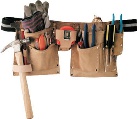Checklist, Tips and Suggestions
|
Checklist to Speedup and Improve a Home Inspection:
CO Testor info.
Proper placement of a carbon monoxide (CO) detector is important. If you are installing only one CO detector, the Consumer Product Safety Commission (CPSC) recommends it be located near the sleeping area, where it can wake you if you are asleep. Additional detectors on every level and in every bedroom of a home provides extra protection against CO poisoning. Homeowners should remember not to install CO detectors directly above or beside fuel burning appliances, as these may emit a small amount of CO, especially at start-up. Appraisals are not home inspections.
Why a Buyer Needs a Home Inspection A home inspection gives the buyer more detailed information than an appraisal--information you need to make a wise decision. In a home inspection, a qualified inspector takes an in-depth, unbiased look at your potential new home to: • Evaluate the physical condition: structure, construction, and mechanical systems. • Identify items that need to be repaired or replaced. • Estimate the remaining useful life of the major systems, equipment, structure, and finishes. What Goes into a Home Inspection A home inspection gives the buyer an impartial, physical evaluation of the overall condition of the home and items that need to be repaired or replaced. The inspection gives a detailed report on the condition of the structural components, exterior, roofing, plumbing, electrical, heating, insulation and ventilation, air conditioning, and interiors. Be an Informed Buyer It is your responsibility to be an informed buyer. Be sure that what you buy is satisfactory in every respect. You have the right to carefully examine your potential new home with a qualified home inspector. You may arrange to do so before signing your contract, or may do so after signing the contract as long as your contract states that the sale of the home depends on the inspection. 
Homeowners Help Links Expert Advice for Home Repair-Home Tips.com
Helpful Info. for the Handyman-DIY Network Home Maintenance and Repairs-About.com Tips from a Handyman-The Natural Handyman Inpsectapedia Life expectancy of stuff around the House Home and Business Inspector Directories National Home Inspector Referral Directory Georgia Home Inspector Referral Directory If you have questions or concerns Give me a call anytime. Brian Simms, cell 706-252-1357 I WILL answer. |
Seven Signs of a Bad Roof:

Virtual Home Inspection Tour!
This brief tour has eight sections that display photo examples and audio clips of what a standard home inspection includes. The video can't possibly detail every item that is inspected, but it does provide a good sense for what an inspection includes. The Home Inspection Process
To avoid delays and to ensure that you get a complete inspection; When setting up the inspection appointment, ask the listing agent to have the home inspection ready. Making sure of the following;
Many homes have the utilities turned off so make sure that if you or your Realtor set up the inspection appointment, that you request that the home gets fully prepared for an inspection, so a full evaluation of the electrical system, plumbing system, heating/cooling system, and water heating system can be done. 1. Has your purchase agreement been accepted? If so - Great! 2. Once you have an accepted purchase agreement; Please email me as much of the following information as you can. A. Your name, email, current address, inspection address and your telephone number. B. Your agents name and phone number (if you are using one). C. The selling (listing agents) name and phone number. (So that I can schedule with them to inspect the home) D. The MLS number E. Any Disclosure Statements, if possible. 3. I will call you and we can choose an inspection time that is convenient. 4. Then I will make the appointment, call you back and confirm the time. 5. The day of the inspection, you are welcome to be there during the entire two to four hour inspection (honestly most people get bored) or if you want I can call you when I am about 30 minutes from completion and you can come over then. 6. We will do a complete walk through where I will explain any deficiencies or maintenance issues that I observed during my home inspection and I will also answer any questions you might have. 7. The report will be emailed to the customer shortly after the home inspection. This is a full report covering all of the house systems including interior, exterior, roof, plumbing, electrical, heating and cooling, ventilation/insulation, and structure with color pictures where necessary to help explain any deficiencies. I also include the model and serial numbers of the furnace and A/C units (if possible), along with suggestions of action to remedy any deficiencies, and maintenance tips on various aspects of the home. |
